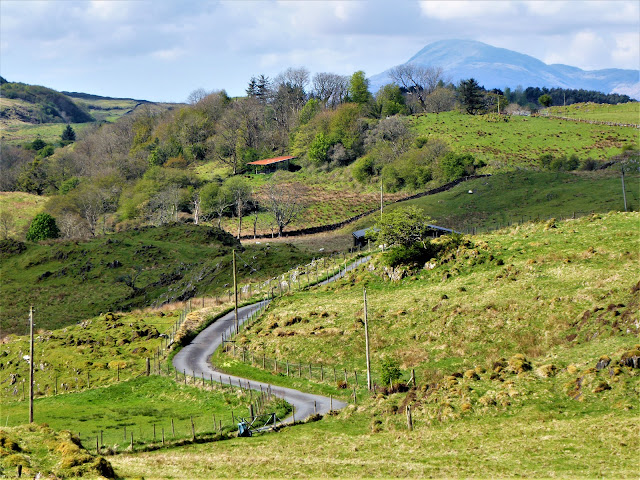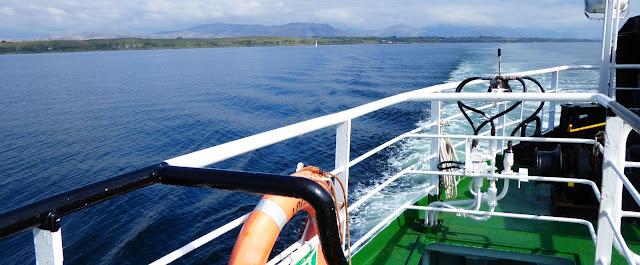How wonderful it was to finish up for a week's holiday. With the rucsack packed and the train ticket booked, the final act of work was putting on the out of office reply. It was even better to be heading off in the shoulder season when the trails were quiet and the crowds of summer dissipated. So for my October week off, I chose to do a multi day walk from Carrbridge to Newtonmore. Much of the route I'd walked before but some of the trails would be new to me and either way, I had never walked the whole lot in one trip so I was looking forward to it.
Grey was the colour of much of the walk with a perpetual ceiling of low cloud and nights that were fair drawing in. But the weather was calm with no wind, no precipitation and only brief moments of sunshine. There was one such moment at the start of the walk at Carrbridge as a few rays penetrated the gloom hanging over the Cairngorms while I walked to Boat of Garten via the Carr Plantation. The dense commercial forestry added to the gloom as trees crowded in and so I was happy to leave it behind at Boat and continue through the native pine woods to Loch Garten. It was already dark as I skirted the loch shore looking for a flat spot for the tent.
From Loch Garten I followed the Speyside Way the following morning to Aviemore and was amazed how the open moor it once crossed was regenerating into dense forest. To my left the bulk of the northern Cairngorms rose into low cloud, a presence hinted at rather than seen.
Popping out of the other side of Aviemore took me to the tree-fringed waters of Loch an Eilean and then onwards to a favourite camp spot deeper in the woods. A jay flew by, small birds twittered in the canpoy and two owls hooted in the evening darkness, one so loud that it must have been right above my tent.
The next day I continued walking along forest trails to Feshiebridge and then picked up a favourite path up the early part of the glen that follows the river through old birch trees. There was a quietness and stillness here far from human generated noise. The woods held some lingering autumn colour and a wild, boreal atmosphere. I wandered up the glen as far as the outflow of Coire Garbhlach, a giant gouge in the side of the hill sculpted by the river that drains the Moine Mhor, the vast plateau above. I pitched the tent close by in a small copse of pines whose canopy brought the darkness in even earlier. With not getting away last year at this time because of lockdown, I think I had forgotten how long the evenings are in the tent in early winter and that night I started the second reading of the small book I'd brought.
The next day was my favourite of the trip. I took a new trail (or new to me at least) from Glen Feshie over the hills towards Drumguish. This was a lovely walk, quiet and empty, and placed me in a good position for a climb up Croidh-la, a little hill rising above Gleann Chomraig.
Here again were regenerating woods where miniature birch trees and pines grew free of the grasses. A thin path climbed the ridge of the hill and was really pleasing to walk. It gave lovely views down to Drumguish and the Spey Valley beyond. Then the sun broke through as I approached the top. It turned the early winter hills to shades of gold and burned off a little of the mist on the bigger tops to reveal a dusting of snow. As is often the way, this smaller, slightly detached hill afforded fantastic views of the bigger hills all around.
Despite the sunshine, there was a bitter wind on top and I didn't linger long which proved to be lucky. The west face of Croidh-la drops almost sheer into Glen Tromie and as I descended a white-tailed eagle glided right by me on thermals pushed up by the steep hillside. I continued downwards as the sun began to dip and after a bit of hunting around found a nice camp spot beside the river with a view to the Feshie hills.
After a peaceful night, I packed up the tent for the last time on this trip and continued the walk to Drumguish then onto Kingussie via pleasant paths through more old birch forest. I left Kingussie out the back of town for a favourite walk to Netwonmore via Loch Gynack. I love the old woods here that fringe the loch and smother the path up Creag Bheag, the wee hill above town. I like the contrast of this walk too as it leaves the woods for a section of open moor before descending to Newtonmore and back into the woods.
I'd timed my route today to get the late train home so that I would finish my walk in the dark. I like dusk with its change in sounds and atmosphere. And I like to see how far I can walk into the darkness before having to switch on the headtorch to illuminate the path or tree roots or the gushing river below. Newtonmore was dark, quiet and deserted. With the summer tourists gone and not enough snow yet for the ski season, it must also have had on its out of office reply.





















































